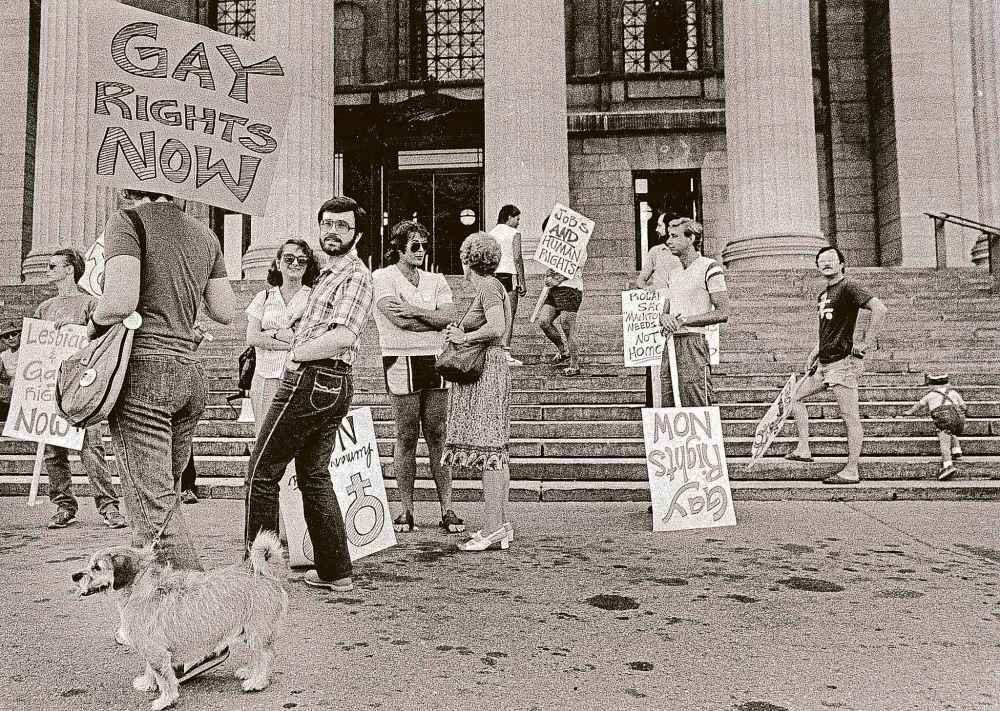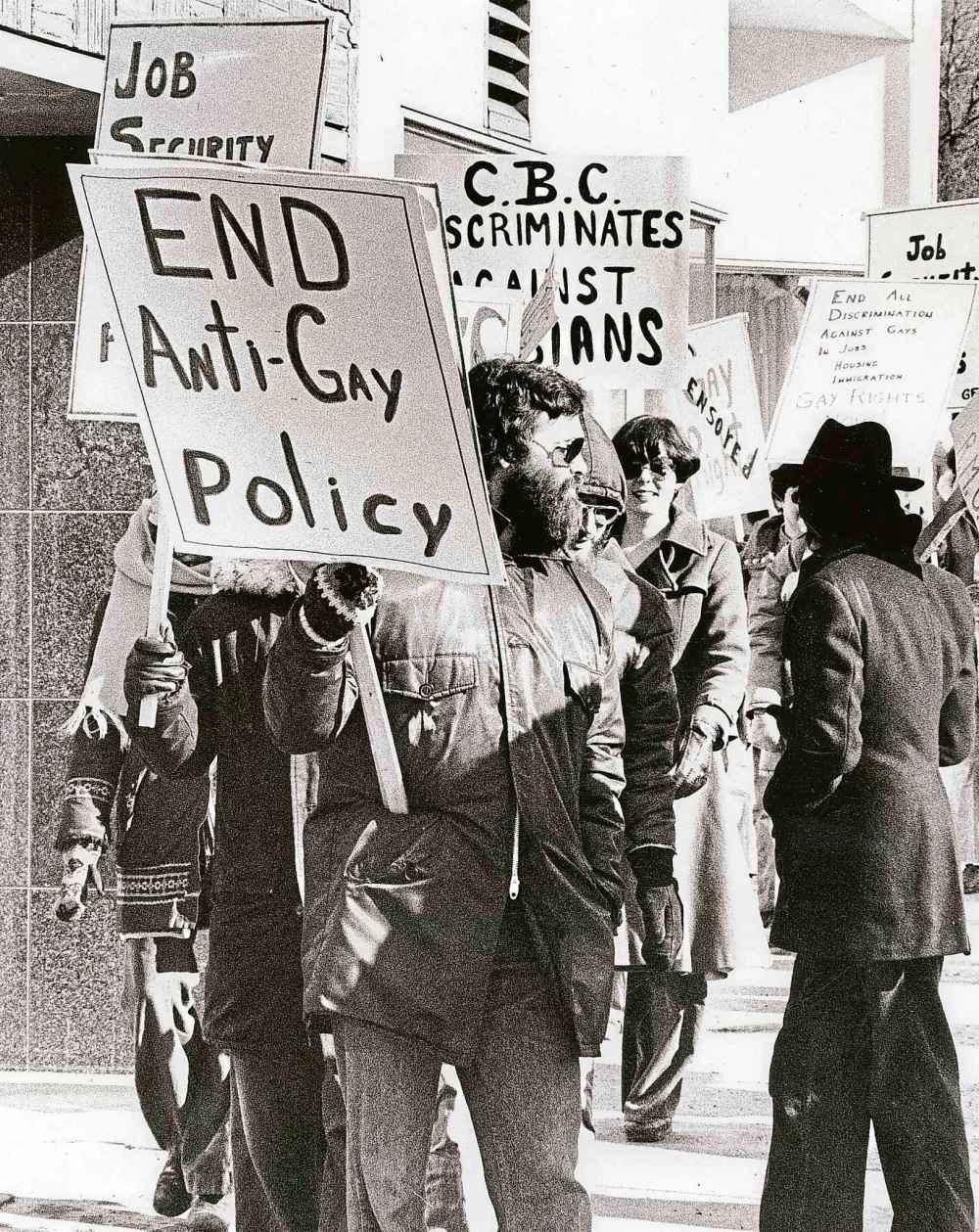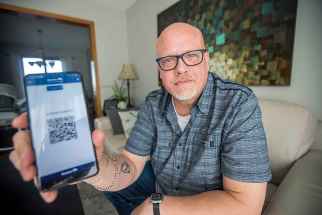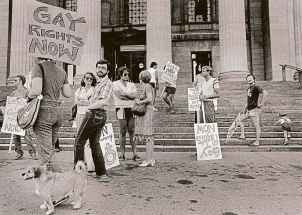Bringing ‘Purge’ to light Exhibit on persecution of LGBTTQ+ Canadians back on track after reckoning at CMHR
Read this article for free:
or
Already have an account? Log in here »
To continue reading, please subscribe:
Monthly Digital Subscription
$0 for the first 4 weeks*
- Enjoy unlimited reading on winnipegfreepress.com
- Read the E-Edition, our digital replica newspaper
- Access News Break, our award-winning app
- Play interactive puzzles
*No charge for 4 weeks then price increases to the regular rate of $19.00 plus GST every four weeks. Offer available to new and qualified returning subscribers only. Cancel any time.
Monthly Digital Subscription
$4.75/week*
- Enjoy unlimited reading on winnipegfreepress.com
- Read the E-Edition, our digital replica newspaper
- Access News Break, our award-winning app
- Play interactive puzzles
*Billed as $19 plus GST every four weeks. Cancel any time.
To continue reading, please subscribe:
Add Free Press access to your Brandon Sun subscription for only an additional
$1 for the first 4 weeks*
*Your next subscription payment will increase by $1.00 and you will be charged $16.99 plus GST for four weeks. After four weeks, your payment will increase to $23.99 plus GST every four weeks.
Read unlimited articles for free today:
or
Already have an account? Log in here »
Hey there, time traveller!
This article was published 05/10/2021 (1528 days ago), so information in it may no longer be current.
The Canadian Museum for Human Rights announced Tuesday an advisory council for a major project surrounding the LGBT Purge, a period in Canadian history marked by systemic discrimination against members of the LGBTTQ+ community working in the federal government and Canadian Armed Forces.
Throughout the Purge, which started in the 1950s and began to end in the 1980s, thousands of Canadians lost their jobs or faced harassment and interrogation due to their sexual identity, which federal agencies viewed as a threat. Subject to ridicule, professional disgrace and psychological trauma, with their identities labelled as “abnormal or deviant,” a great many suffered financial ruin and self-harm, in some cases, dying by suicide.
“People don’t know it happened,” says Michelle Douglas, the executive director of the LGBT Purge Fund, a non-profit corporation created in the wake of a historic $145-million class-action suit filed against the federal government in 2018.
When Douglas was 23 years old, she was a lieutenant in the Canadian Armed Forces. By all accounts, she was the exact type of recruit — ambitious, capable, strong-willed — any federal organization was looking for.

But then, an abrupt end. In 1989, it became known that Douglas was in a relationship with a woman, and the young officer was swept away by the military police to a hotel in Toronto, interrogated for two days, and shuttled to Ottawa, where she said federal colleagues forced her to take a polygraph, or lie detector, test.
While hooked up to the machine, facing mounting pressure, Douglas admitted to being a lesbian. “And that led to me being dismissed,” she recalled this week. Her release documents reasoned that she was “not advantageously employable due to homosexuality.”
Douglas was not alone, and today is one of thousands of survivors of the LGBT Purge.
Despite its recency, most Canadians don’t know the Purge occurred, Douglas said, which is why she was heartened the fund established a relationship with the Canadian Museum for Human Rights in 2017.

The relationship began on a positive note, with the national museum looking to highlight and interrogate the injustices that occurred within organizations as embroiled with Canadian identity as the Armed Forces, mounted police and federal public service.
That mutually respectful relationship was marred last summer by allegations levied against the museum, which opened in 2014. Former and current employees alleged that on some school tours between 2015 and 2017, LGBTTQ+ content was censored and excluded, an accommodation made for certain groups that the museum later acknowledged in an apology was contradictory to its mission statement.
Other allegations of racism and discrimination followed, including complaints of sexual harassment, bullying and abuse. An external investigation in August 2020 concluded the federal institution suffered from a culture burdened by “pervasive and systemic” racism, which for years had gone unaddressed by senior management.
The investigation, conducted by Winnipeg lawyer Laurelle Harris through interviews with more than 25 former and current (at the time) employees, found experiences of sexism, heterosexism, homophobia and transphobia, plus pay diparities and promotion politics which Indigenous, Black, and employees of colour felt favoured white candidates over themselves.
“People don’t know it happened.” – Michelle Douglas
Forty-four recommendations were made to repair the organization’s relationship with the public and its employees, including that the next CEO be a member of a BIPOC (Black, Indigenous, People of Colour) community and that the board be more representative of marginalized groups. In June, the museum’s president and CEO, John Young, resigned early, opening the door for a replacement.
Partnering organizations, including the LGBT Purge Fund and Pride Winnipeg, were put in an awkward spot and had to reconsider their relationships with the museum. Pride Winnipeg cut ties in June 2020, and the Purge Fund paused its work temporarily.
“I was personally shattered to read about the allegations made against the CMHR,” Douglas said Tuesday. “So we undertook a very serious, deliberate effort to consider what it would take for us to re-engage and reconcile.”
In August 2020, human rights lawyer Isha Khan was named as Young’s replacement, though she applied to the post in the winter, long before the museum faced public scrutiny. The former executive director of the Manitoba Human Rights Commission was tasked with righting the ship, and implementing the recommendations made in Harris’s report.
“I was personally shattered to read about the allegations made against the CMHR.” – Michelle Douglas
On her first day, Khan phoned Douglas to tell her she knew the challenges ahead and was ready to meet them, wanting to get started as soon as possible. “That was important to us,” said Douglas. “We considered it a very good sign.”
Conversations continued with the museum’s new senior leadership, as well as with museum staff, said Douglas, and soon, the fund reached a consensus that it could recommence the relationship and move forward on the exhibit and other educational opportunities. A second report compiled by Harris was released last June, highlighting progress in certain areas of equity and diversity as well as persisting concerns over discrimination, accountability and representation.
“I think we’re making progress,” Khan told the Free Press in June. “I think we’re making change and it takes time, and I knew that it would take time but I’m certainly not doing it alone. I’m doing it with a whole team of people, so the work for us is making sure everyone takes responsibility and everyone sees themselves in the work.”
Douglas said her organization also hired an independent consultant to gauge community concerns, and drafted a letter to the institution highlighting areas of concern.
“We wanted to see a plan for the exhibit to be inclusive and for any council to reflect a diverse and inclusive membership, and I think they’ve done just that.” – Michelle Douglas
“We wanted to see a plan for the exhibit to be inclusive and for any council to reflect a diverse and inclusive membership, and I think they’ve done just that,” Douglas said.
The 19-member body features 10 survivors of the Purge, Douglas included, plus academics, elders, legal scholars, historians, and educators. Co-chairs are CMHR vice-president of external relations and community engagement, Riva Harrison, and Douglas Elliot, an LGBT Purge Fund board member and the lead lawyer of the class action. Local members include U of M history professor David Churchill and two-spirit elder Albert McLeod.
Harrison, who joined the museum earlier this year, said a lot of work has been going on to make amends over the past year, and the council is one part of it. “I think when it comes to what happened at the museum, we have to accept responsibility for our failings and acknowledge what went on. That includes apologizing, reaching out, having conversations about what can be done better,” she said, adding that the museum has boosted diversity hiring, set up a rainbow equity council, and implemented many of the recommendations.
“It’s about saying never again to the things that happened,” she said. “I think we are working together on an extremely important project, but we still have trust to build… We still have work to do and we’re honoured to be able to do it.”

In the coming years, the council will use lived experience as a basis for the work museum staff do in developing curatorial and educational materials, an action Douglas said is needed to rebuild trust. By 2024, an exhibition on the Purge will open in the museum’s Level 1 gallery, previously the site of the well-received Mandela: Struggle for Freedom exhibition.
Ultimately, she said, this work is vital in not only educating Canadians about the discrimination faced historically by members of the LGBTTQ+ community, but today, in many fields and in different ways.
“We know as victims of the purge that many of our neighbours, friends and people across the country don’t know these stories,” she said. “But we think they must.”
ben.waldman@freepress.mb.ca

Ben Waldman covers a little bit of everything for the Free Press.
Our newsroom depends on a growing audience of readers to power our journalism. If you are not a paid reader, please consider becoming a subscriber.
Our newsroom depends on its audience of readers to power our journalism. Thank you for your support.





